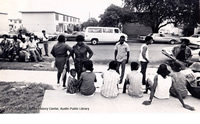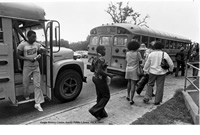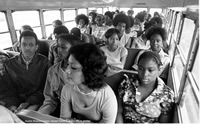|
| Key |
|---|
 |
Local African American firsts |
 |
University of Texas at Austin (UT) facts |
 |
Local desegregation facts |
 |
Statewide desegregation facts |
 |
National desegregation facts |
Note: The Austin American-Statesman newspaper had several name changes over the five decades covered in this timeline. The variations reflect usage for that time—Austin Statesman, The Austin Statesman, The Austin-Statesman, The Austin American, The Austin American-Statesman, American Statesman, The American-Statesman, Austin American-Statesman.
|
overview |
1940s |
1950s |
1960s |
1970s |
1980s |
all
1970 |
1971 |
1972 |
1973 |
1974 |
1975 |
1976 |
1977 |
1978 |
1979
|
1970
|
 |
The Department of Health, Education and Welfare finds that the Austin ISD is in violation of the 1964 Civil Rights Act because of the existence of eight predominantly black schools. [AF-Segregation-Public Schools-S1700 (2)-1970; Austin American- Statesman, “School Hearing Concludes,” January 24, 1970] |
 |
The Austin ISD School Board votes unanimously to reject Plan C, a desegregation plan that would have classified Mexican American children as white. [AF-Segregation-Public Schools-S1700 (2)-1970; The Echo, “East Austin Wins First Round in School Board Fight,” May 19, 1970] |
 |
The federal government brings suit against the Austin ISD for alleged failure to comply with desegregation guidelines. [AF-Segregation-Public Schools-S1700 (2)-1970; Austin American-Statesman, “Integration Suit Filed on Austin,” August 08, 1970] |
 |
In an effort to meet federal desegregation guidelines, the school board approves a new teacher crossover plan, which will make the faculty makeup in each school comparable to the composition of the student body. [AF-Segregation-Public Schools-S1700 (2)- 1970; The Austin American, “108 Teachers Will ‘Cross Over&rsquo,” August 13, 1970] |
 |
Anderson High welcomes Mexican American and Anglo student transfers. [AF-Segregation-Public Schools-S1700 (2)-1970s; The Austin American, “Austin Schools Begin Court-Ordered Mixins,” September 01, 1970] |
 |
Two-way busing as the beginning of a school integration problem is advocated by many of the nearly 100 citizens at a public forum. [AF-Segregation-Public Schools-S1700 (2)-1970; The Austin American, “Bus Plan Advocated By Group,” October 09, 1970] |
 |
The Austin ISD Board adopts a desegregation policy regarding staff assignments, classroom, activities, and future school planning. [AF-Segregation-Public Schools-S1700 (2)-1970; The Austin American, “Board Formalizes Integration Policy,” December 15, 1970] |
|
|
1971
|
 |
The Tri-Ethnic Community Council is formed in January to work for equal educational opportunity for all Austin students. [AF-Segregation-S1700 (13)-Tri-Ethnic Community Council] |
 |
U.S. Federal District Court rules that Austin ISD is not discriminating against Mexican American students, and orders the closing of Anderson High, Kealing Jr. High, and St. John’s Elementary. [AF-Segregation-S1700 (2)-Public Schools-1975; The American-Statesman, “Desegregation in Austin,” August 17, 1975] |
 |
During the 1971-72 academic year, twelve black students at The University of Texas conduct door-to-door surveys and density studies and gather signatures on a petition to successfully obtain a shuttle bus route into East Austin. [Marsh Durden, Almetris Overcoming: A History of Black Integration at The University of Texas at Austin. 1979; A 378.76431 DU] |
 |
President Richard M. Nixon announces the government’s decision to take an appeal on limited constitutional grounds in the case of the United States v. Austin Independent School District. [AF-Segregation-Public Schools-S1700 (2)-1971; The Austin American, “Minimum Busing Plan Is Appealed: Nixon Tells His Position,” August 04, 1971] |
 |
Superintendent of Schools Dr. Jack L. Davidson tells an urban renewal agency representative that construction of low-cost housing in the area of Anderson High School would compound the district’s desegregation problems. [AF-Segregation-Public Schools-S1700 (2)-1971; The Austin American, “Low-Cost Housing Hinders Integration, Davidson Says,” February 10, 1971] |
 |
The Austin ISD receives confirmation that it will not be eligible for a share of President Nixon’s $75 million emergency desegregation fund. After much discussion and efforts to secure the funds, the application, which included $14,000 for transportation, was rejected by the Department of Health, Education and Welfare in Dallas. It was rejected because the Austin ISD was not under a permanent court-ordered acceptable desegregation plan. [AF-Segregation-Public Schools-S1700 (2)-1971; The Austin American, “Austin Schools Miss Cash,” February 24, 1971] |
 |
 The Austin ISD adopts two alternative desegregation plans, both calling for the closing of Anderson High School and Kealing Junior High. [AF-Segregation-Public Schools-S1700 (2)-1971; The Austin American, “Integration Plans Voted Kealing, Anderson Would Close,” May 06, 1971]
The Austin ISD adopts two alternative desegregation plans, both calling for the closing of Anderson High School and Kealing Junior High. [AF-Segregation-Public Schools-S1700 (2)-1971; The Austin American, “Integration Plans Voted Kealing, Anderson Would Close,” May 06, 1971] |
 |
The government rests its case in federal court after unveiling a plan for busing 13,103 Austin students at an estimated cost of more than $1 million. [AF-Segregation-Public Schools-S1700 (2)-1971; The Austin American, “Government Rests Its Case,” June 18, 1971] |
 |
A United States District judge orders the immediate implementation of the Austin ISD’s desegregation plan. [AF-Segregation-Public Schools-S1700 (2)-1971; The Austin American, “Local Integration Scheme Wins Nod,” July 20, 1971] |
 |
Anderson High School and Kealing Jr. High close September 1.
[AF-Segregation-Public Schools-S1700 (2)-1971; The Austin Citizen, “Busing Plan Evokes Comment,” July 22, 1971] |
 |
The Austin Chapter of the NAACP Legal Defense and Educational Fund says that “if the Justice Department does not appeal the decision in the Austin desegregation case, it will.” [AF-Segregation-Public Schools-S1700 (2)-1971; The Daily Texan, “NAACP Set To Appeal Austin Plan,” August 03, 1971] |
 |
Students at Kealing Junior High and Anderson High School are given counseling to help crossing over proceed smoothly. [AF-Segregation-Public Schools-S1700 (2)-1971; The Austin American, “Students Given Helping Hand In Crossing to New Schools,” August 12, 1971] |
 |
The City of Austin Human Relations Commission issues a statement asking Austinites to support whatever school desegregation plan is implemented in Austin. [AF-Segregation-Public Schools-S1700 (2)-1971; The Austin American, “School Plan Is Supported By the HRC,” August 25, 1971] |
 |
The Austin Chapter of the NAACP and the Mexican American Legal Defense Fund are granted permission by the Fifth U.S. Circuit Court of Appeals to intervene in the Austin school desegregation case pending before the court. [AF-Segregation-Public Schools-S1700 (2)-1971; The Austin American, “2 Groups In School Appeal,” August 25, 1971] |
 |
The Fifth U.S. Circuit Court of Appeals grants a nine-day extension is to the federal government, giving the Department of Health, Education and Welfare until Sept. 3 to file a brief in the Austin school desegregation case. [AF-Segregation-Public Schools-S1700 (2)-1971; The Austin American, “Nine-Day Extension Granted,” August 26, 1971] |
 |
 Busing gets off to a smooth start on its first day. [AF-Segregation-Public Schools-S1700 (2)-1971; The Austin American, “Busing Gets Off To Smooth 1st Day,” August 31, 1971]
Busing gets off to a smooth start on its first day. [AF-Segregation-Public Schools-S1700 (2)-1971; The Austin American, “Busing Gets Off To Smooth 1st Day,” August 31, 1971] |
 |
Tension under the strain of forced integration sets off a series of fights and boisterous student confrontations that disrupt A.N. McCallum High School and shut down classes shortly after noon. [AF-Segregation-Public Schools-S1700 (2)-1970s; The Austin American, “Race Tension Sparks Clash,” September 02, 1971] |
 |
 The Federal Justice Department outlines its appeal of the Austin school desegregation plan and agues against excessive busing, a turn in the department’s stance.
[AF-Segregation-Public Schools-S1700 (2)-1971; The Austin American, “Feds Against Heavy Busing,” September 08, 1971]
The Federal Justice Department outlines its appeal of the Austin school desegregation plan and agues against excessive busing, a turn in the department’s stance.
[AF-Segregation-Public Schools-S1700 (2)-1971; The Austin American, “Feds Against Heavy Busing,” September 08, 1971] |
|
|
1972
|
 |
The University of Texas invites the National Congress of Black Professionals to meet at the LBJ Auditorium to discuss problems of blacks in higher education.
[Marsh Durden, Almetris. Overcoming: A History of Black Integration at The University of Texas at Austin. 1979; A 378.76431 DU] |
 |
The U.S. Fifth Circuit Court of Appeals orders a federal plan for desegregation to be submitted; appeals judges issue conflicting opinions and remand the Austin case to federal district court for retrial. [AF-Segregation-Public Schools-S1700 (2)-1972; The Austin American-Statesman (Evening Edition), “Desegregation Chronology,” November 22, 1977] |
|
|
1973
|
 |
The U.S. Department of Health, Education, and Welfare grants Austin ISD half a million dollars to assist in desegregation efforts that will “eliminate, reduce or prevent minority group isolation.” [AF-Segregation-Public Schools-S1700 (2)-1973; Austin American-Statesman, “AISD To Get Federal Grant For Desegregation Efforts,” February 24, 1973] |
 |
Austin ISD Board approves a plan that proposes to request over half a million dollars from Emergency School Assistance Act funds to implement an Austin ISD plan that deals with the isolation of minority students. [AF-Segregation-Public Schools-S1700 (2)-1973; The Austin American, “Austin Trustees Approve Plan On District Desegregation,” April 26, 1973] |
 |
Austin ISD again faces charges of discrimination in district court when the Fifth U.S. Circuit Court of Appeals overturns District Judge Jack Roberts’ original decision that “no discrimination against Mexican Americans existed in Austin.” [AF-Segregation-Public Schools-S1700 (2)-1973; The Daily Texan, “AISD Faces Charges Again,” May 07, 1973] |
 |
The Mexican American Legal Defense Fund presents a study in the Austin school desegregation case that indicates that the restrictive covenants that have existed in the city from 1923-1960 contributed to the racially segregated housing patterns in the city. Although no longer legal, the covenants historically have “disallowed total freedom of choice in the area of residential site selection.” [AF-Segregation-Public Schools-S1700 (2)-1973; Austin American-Statesman, “Housing Pattern Linked to Deeds,” May 12, 1973] |
 |
Austin sixth graders will attend one of eight specially integrated centers that represent the heart of a school desegregation plan filed by the Austin ISD in District Court. [AF-Segregation-Public Schools-S1700 (2)-1973; The Austin American, “Okayed School Plan Centers On Integrating 6th Graders,” August 02, 1973] |
 |
Parents from two prospective sixth-grade schools submitted alternative desegregation plans to Austin ISD Board of Trustees, which will keep their schools grades kindergarten through five. [AF-Segregation-Public Schools-S1700 (2)-1973; Austin American-Statesman, “Sixth Graders’ Parents Give Alternate Desegregation Plan,” August 12, 1973] |
|
|
1974
|
 |
Six 6th grade centers open at the start of the school year.
[AF-Segregation-Public Schools-S1700 (2)-1974; The Austin American-Statesman (Evening Edition), “Desegregation Chronology,” November 22, 1977] |
 |
A hearing is held in federal court on the proposed construction of Sanchez, Houston and Williams elementary schools; construction is delayed due to government and intervenor objections. [AF-Segregation-Public Schools-S1700 (2)-1974; The Austin American-Statesman (Evening Edition), “Desegregation Chronology,” November 22, 1977] |
 |
Intervenors agree to proposed sites for Williams, Sanchez and Houston elementary schools and construction begins. Austin ISD submits proposals for a new southwest high school and northeast junior high, and the government objects to both. [AF-Segregation-Public Schools-S1700 (2)-1974; The Austin American-Statesman (Evening Edition), “Desegregation Chronology,” November 22, 1977] |
|
|
1975
|
 |
The Austin Chapter of the NAACP criticizes proposed Oak Hill site for a southwest high school. [AF-Segregation-Public Schools-S1700 (2)-1975; The Austin Citizen, “Segregation ‘Seeds’ Will Surely Grow,” May 17, 1975] |
 |
The school district’s new transfer policy sparks a movement by parents to begin registering their children in schools with low enrollments, but it did not result in an exodus from the campuses labeled the “least fundamental” in the city by the Awareness League, an Austin based organization that advocates for a more disciplined and structured school environment. Under the policy, Trustees designated A.N. McCallum High, Lamar and O. Henry Junior High, and 13 elementary schools as “open enrollment schools,” and agreed to accept all student transfers to those facilities, as long as the parents or students provide their own transportation. [AF-Segregation-Public Schools-S1700 (2)-1975; The Austin Citizen, “Transfer Rule Gets Response,” May 31, 1975] |
 |
Austin ISD files an answer to proposed sites for Williams, Sanchez and Houston elementary schools and construction begins. Austin ISD proposes constructing northeast junior high school, but intervenors object. Austin ISD makes plans for a new southwest high school, but intervenor dissatisfaction prompts district to postpone hearing in federal court. [AF-Segregation-Public Schools-S1700 (2)-1975; The Austin American-Statesman, “Desegregation in Austin,” August 17, 1975] |
|
|
1976
|
 |
The Black Business Association forms at The University of Texas at Austin to provide a means for students in the College of Business to network. [Marsh Durden, Almetris. Overcoming: A History of Black Integration at The University of Texas at Austin. 1979; A 378.76431 DU] |
 |
U.S. District Judge Jack Roberts appoints 21 persons to serve on a tri-ethnic committee to help plan Austin’s school integration. [AF-Segregation-Public Schools-S1700 (2)-1976; The Austin Citizen, “21 Named to Deseg Panel,” July 02, 1976] |
 |
In May, the Fifth U.S. Circuit Court of Appeals remands the Austin ISD plan back to a local federal judge, in effect calling for further desegregation and possible abolition of sixth-grade schools. Heated community reaction follows in wake of the federal appeals decision. The school district appeals to the U.S. Supreme Court. [AF-Segregation-Public Schools-S1700 (2)-1976; The Austin American-Statesman (Evening Edition), “Desegregation Chronology,” November 22, 1977] |
 |
In December, the Supreme Court strikes down the school desegregation order issued by the appeals court, and most plans in the district for top-to-bottom desegregation are halted. The case is sent back to the Fifth U.S. Circuit Court of Appeals with an order from the Supreme Court to review the previous order. [AF-Segregation-Public Schools-S1700 (2)-1976; The Austin American-Statesman (Evening Edition), “Desegregation Chronology,” November 22, 1977] |
|
|
1977
|
 |
The Austin Chapter of the NAACP calls for the removal of a Burnet Junior High School assistant principal they label as “rude, insensitive and sarcastic to students and parents.” [AF-Segregation-Public Schools-S1700 (2)-1977; The Austin Citizen, “Ouster of School Official Sought,” April 18, 1977] |
 |
On November 21, the Fifth U.S. Circuit Court of Appeals rules for the third time that the Austin district intentionally segregates its Chicano students, and sends the case once again to federal district court for rehearing. The Austin desegregation case is now seven years old. [AF-Segregation-Public Schools-S1700 (2)-1977; The Austin American-Statesman (Evening Edition), “Desegregation Chronology,” November 22, 1977] |
 |
A retrial is held in federal district court, and the judge finds that there is no unlawful segregation against Mexican American students. He orders the creation of sixth-grade learning centers to desegregate that grade and orders AISD to request approval of construction of new schools by intervenors (NAACP and Mexican American Legal Defense Education Fund). Intervenors and the government file appeal briefs with the Fifth Circuit Court of Appeals. [AF-Segregation-Public Schools-S1700 (2)-1977; The Austin American-Statesman (Evening Edition), “Desegregation Chronology,” November 22, 1977] |
|
|
1978
|
 |
Two Mexican American organizations band together in an effort to unify Austin Chicanos on school desegregation and other educational issues. A 12-member task force is organized to find out how Mexican-Americans feel about their public schools and how to make those feelings known. [AF-Segregation-Public Schools-S1700 (2)-1978; The Austin American-Statesman, “Groups Plan Joint Desegregation Push: Chicano Unity Sought on School Issue,” February 05, 1978] |
|
|
1979
|
 |
A coalition of Mexican American groups charges Austin ISD with negotiating in bad faith on desegregation and said the issue will have to be settled in court. [AF-Segregation-Public Schools-S1700 (2)-1979; The Austin Citizen, “AISD Accused of Bad Faith in Desegregation,” May 30, 1979] |
 |
Austin School officials express disappointment and confusion at the Supreme Court’s decision to let stand a lower court ruling that the AISD intentionally discriminated against Mexican Americans in drawing up its desegregation plans. [AF-Segregation-Public Schools-S1700 (2)-1979; The Daily Texan, “Supreme Court Rules that AISD was Discriminatory,” July 03, 1979] |
 |
The first day of the federal district court “remedy trial” begins in Austin desegregation case. The two-fold purpose of the trial is to determine the extent of the Austin ISD’s constitutional violations in segregating blacks and Mexican Americans and to prescribe a remedy in the form of a desegregation plan. [AF-Segregation-Public Schools-S1700 (2)-1979; The Austin Citizen, “AISD Desegregation ‘Remedy Trial’ Begins,” July 11, 1979] |
 |
An Austin ISD attorney disputes testimony that school board actions are a significant factor in housing segregation. [AF-Segregation-Public Schools-S1700 (2)-1979; The Austin Citizen, “District Disputes Its Policies Spurred Housing Segregation,” July 24, 1979] |
 |
An urban planning expert disputes testimony by school district witnesses that economic factors are overriding causes of segregated housing. [AF-Segregation-Public Schools-S1700 (2)-1979; The Austin Citizen, “Urban Planner Blames AISD for Segregation,” July 25, 1979] |
 |
The parties to the Austin desegregation lawsuit prepare to file a consent decree in the federal district court, ending nearly 9 ½ years of litigation. [AF-Segregation-Public Schools-S1700 (2)-1979; The Austin Citizen, “15,000 to be Bused; Deseg Agreement Reached; Judge Roberts to Get Proposal,” December 17, 1979] |
 |
Approximately 300 Anderson High School students storm the Carruth Administration building, waving anti-busing signs, chanting “Hell, no, we won’t go.” [AF-Segregation-Public Schools-S1700 (2)-1979; The Austin Citizen, “300 Storm Carruth Building; Students: We Won’t Go,” December 10, 1979] |
|
|




